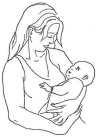Human Lateralization, Maternal Effects and Neurodevelopmental Disorders
- PMID: 33828467
- PMCID: PMC8019713
- DOI: 10.3389/fnbeh.2021.668520
Human Lateralization, Maternal Effects and Neurodevelopmental Disorders
Abstract
In humans, behavioral laterality and hemispheric asymmetries are part of a complex biobehavioral system in which genetic factors have been repeatedly proposed as developmental determinants of both phenomena. However, no model solely based on genetic factors has proven conclusive, pushing towards the inclusion of environmental and epigenetic factors into the system. Moreover, it should be pointed out that epigenetic modulation might also account for why certain genes are expressed differently in parents and offspring. Here, we suggest the existence of a sensitive period in early postnatal development, during which the exposure to postural and motor lateral biases, expressed in interactive sensorimotor coordination with the caregiver, canalizes hemispheric lateralization in the "typical" direction. Despite newborns and infants showing their own inherent asymmetries, the canalizing effect of the interactive context owes most to adult caregivers (usually the mother), whose infant-directed lateralized behavior might have been specifically selected for as a population-level trait, functional to confer fitness to offspring. In particular, the case of the left-cradling bias (LCB; i.e., the population-level predisposition of mothers to hold their infants on the left side) represents an instance of behavioral trait exhibiting heritability along the maternal line, although no genetic investigation has been carried out so far. Recent evidence, moreover, seems to suggest that the reduction of this asymmetry is related to several unfavorable conditions, including neurodevelopmental disorders. Future studies are warranted to understand whether and how genetic and epigenetic factors affect the lateralization of early mother-infant interaction and the proneness of the offspring to neurodevelopmental disorders.
Keywords: autism spectrum disorders; behavioral epigenetics; cradling-side bias; hemispheric asymmetry; laterality; mother-infant interaction.
Copyright © 2021 Malatesta, Marzoli, Prete and Tommasi.
Conflict of interest statement
The authors declare that the research was conducted in the absence of any commercial or financial relationships that could be construed as a potential conflict of interest.
Figures
Similar articles
-
Maternal cradling bias: A marker of the nature of the mother-infant relationship.Infant Behav Dev. 2022 Feb;66:101680. doi: 10.1016/j.infbeh.2021.101680. Epub 2021 Dec 3. Infant Behav Dev. 2022. PMID: 34871828
-
Received Cradling Bias During the First Year of Life: A Retrospective Study on Children With Typical and Atypical Development.Front Psychiatry. 2020 Feb 27;11:91. doi: 10.3389/fpsyt.2020.00091. eCollection 2020. Front Psychiatry. 2020. PMID: 32174855 Free PMC article.
-
Mother and offspring lateralized social behavior across mammalian species.Prog Brain Res. 2018;238:115-141. doi: 10.1016/bs.pbr.2018.06.003. Epub 2018 Jul 2. Prog Brain Res. 2018. PMID: 30097190 Review.
-
Maternal cradling bias in baboons: The first environmental factor affecting early infant handedness development?Dev Sci. 2022 Jan;25(1):e13179. doi: 10.1111/desc.13179. Epub 2021 Oct 18. Dev Sci. 2022. PMID: 34626051
-
Atypical lateralization in neurodevelopmental and psychiatric disorders: What is the role of stress?Cortex. 2020 Apr;125:215-232. doi: 10.1016/j.cortex.2019.12.019. Epub 2020 Jan 16. Cortex. 2020. PMID: 32035318 Review.
Cited by
-
Amplitude of low-frequency fluctuation-based regional radiomics similarity network: Biomarker for Parkinson's disease.Heliyon. 2023 Mar 6;9(3):e14325. doi: 10.1016/j.heliyon.2023.e14325. eCollection 2023 Mar. Heliyon. 2023. PMID: 36950566 Free PMC article.
-
Alteration of a brain network with stable and strong functional connections in subjects with schizophrenia.Schizophrenia (Heidelb). 2022 Nov 4;8(1):91. doi: 10.1038/s41537-022-00305-0. Schizophrenia (Heidelb). 2022. PMID: 36333328 Free PMC article.
-
Editorial: Expert opinion in environmental and genetic factors impacting functional brain lateralization in development and evolution.Front Behav Neurosci. 2023 May 31;17:1215176. doi: 10.3389/fnbeh.2023.1215176. eCollection 2023. Front Behav Neurosci. 2023. PMID: 37324522 Free PMC article. No abstract available.
-
Broadening the scope: Increasing phenotype diversity in laterality research.Front Behav Neurosci. 2022 Oct 28;16:1048388. doi: 10.3389/fnbeh.2022.1048388. eCollection 2022. Front Behav Neurosci. 2022. PMID: 36386787 Free PMC article. No abstract available.
-
Associations between handedness and brain functional connectivity patterns in children.Nat Commun. 2024 Mar 15;15(1):2355. doi: 10.1038/s41467-024-46690-1. Nat Commun. 2024. PMID: 38491089 Free PMC article.
References
LinkOut - more resources
Full Text Sources
Other Literature Sources


